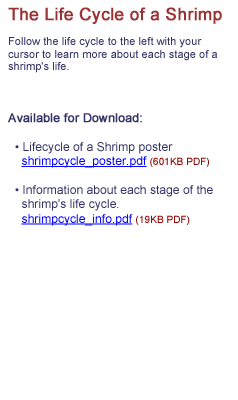Home
> Biological
Info > A Shrimp's Niche
In Its Ecosystem

The shrimp
fisheries in the Gulf of Mexico are some of the most valuable
fisheries in the United States (Van Voorhees and Prichard
2004). Because temperature and salinity changes affect the
life stages of each shrimp species in a slightly different
manner, shrimp occupy many niches in Louisiana’s estuaries
and in Gulf waters. Reproducing populations of several species
of shrimp mature through the postlarval and subadult stages
in Louisiana’s estuaries at slightly different times
of the year, sometimes overlapping in habitat use, sometimes
occupying different niches in state waters. The two shrimp
species harvested by the state’s commercial shrimpers
– the brown shrimp (Farfantepenaeus aztecus)
and white shrimp (Litopenaeus setiforus) –
represent 95 percent of all annual landings. Very small quantities
of other shrimp species such as seabobs, pink shrimp, rock
shrimp and royal reds have also been caught in Louisiana’s
waters. Brown shrimp usually spawn earlier in the year, and
are most abundantly harvested in May, June and July whereas
white shrimp are most abundantly harvested in August, September,
and October. However, some adults of both species are available
throughout a large portion of the year. In Louisiana’s
waters, 60-65 percent of white shrimp are harvested in coastal
or bay waters, whereas the majority of brown shrimp in Louisiana
are harvested in deeper, outside regions. This is different
from other Gulf states, where shrimp harvests of all species
tend to be higher offshore, outside of state waters.
Although
commercial shrimpers harvest almost as many brown as white
shrimp in a given year, white shrimp typically grow to a larger
size before they are harvested. For example, in 2004, white
shrimp accounted for 55 percent of the year’s landings,
but nearly 70 percent of its value, according to the Louisiana
Department of Wildlife and Fisheries. This size difference
occurs because white shrimp remain longer in estuaries, responding
only to very strong tidal changes that stimulate movement
in and out of the estuaries. White shrimp also tend to migrate
back through the passes into estuaries over winter.
In addition
to their value to commercial fisheries, shrimp are important
in estuarine and offshore food webs. The interactions of many
different living, growing organisms with each other and the
physical environment shape a shrimp’s niche (i.e., its
role in the environment, the species it interacts with, and
its environmental requirements for food and shelter). The
continuous but changing characteristics of a shrimp’s
niche can be seen by studying the major life stages of this
important crustacean.
|
 |
References
Muncy, R.J. 1984. Species Profiles: Life Histories and Environmental
Requirements of Coastal Fishes and Invertebrates (Gulf of
Mexico)—White Shrimp. U.S. Fish and Wildlife Service,
FWS/OBS-82/11.20. U.S. Army Corps of Engineers, TR EL-82-4.
19 pp.
Lassuy,
D.R. 1983. Species Profiles: Life Histories and Environmental
Requirements (Gulf of Mexico) – Brown shrimp. U.S. Fish
and Wildlife Service, Division of Biological Services. FWS/OBS-82/11.1.
U.S. Army Corps of Engineers, TR EL-82-4. 15 pp.
Van Voorhees,
David and Elizabeth Prichard. October 2004. Fisheries
of the United States 2003. Annual report of National
Marine Fisheries Service, Office of Science and Technology,
Fisheries Statistics Division. Published by U.S. Department
of Commerce, National Marine Fisheries Service. Available
online at http://www.st.nmfs.gov/st1/fus/fus03/2003_fws.pdf
The
following experts contributed information to this project and
served as a review panel for this summary.
Mark
Benfield, Don Baltz, Gary Peterson – all of LSU Coastal
Fisheries Institute; John Fleeger – LSU Department of
Biological Sciences; Dianne Lindstedt – Louisiana Sea
Grant College Program; and Marty Bourgeois – Louisiana
Department of Wildlife and Fisheries Division of Marine Fisheries.

Development
of this portion of the Louisiana Sea Grant Fisheries Web site
was funded by the Gulf & South Atlantic Fisheries Foundation,
Inc. under NOAA cooperative agreement #NA16FM2817.
The statements, findings, conclusions, and recommendations are
those of the author(s) and do not necessarily reflect the views
of the Gulf & South Atlantic Fisheries Foundation, Inc.,
NOAA, or the Department of Commerce.
|
|